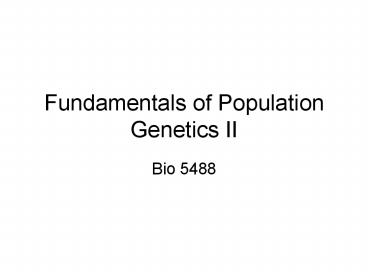Fundamentals of Population Genetics II - PowerPoint PPT Presentation
1 / 27
Title:
Fundamentals of Population Genetics II
Description:
Population Genetics: A concise guide. John Gillespie. Review of ... Molecular clock. Neutral Hypothesis of Population Genetics (and nearly neutral hypothesis) ... – PowerPoint PPT presentation
Number of Views:74
Avg rating:3.0/5.0
Title: Fundamentals of Population Genetics II
1
Fundamentals of Population Genetics II
- Bio 5488
2
A good referencePopulation Genetics A concise
guide. John Gillespie
3
Review of last time
- Wright Fisher Model
- Decay of Ht. Ht H0(1-1/2N)t
- Simple mathematical constructs can provide
non-obvious insights - Power of an analytic attack
4
Department of Corrections
- Probability of fixation of Superman
- How does this change with population size.
5
I 50 A 100 R 99 G 1 fG 3fR
6
I 50 A 100 R 99 G 1 fG 3fR
7
I 1000 A 2000 R 1999 G 1 fG 3fR
8
An interesting point
- You are given two alleles, R and G. If the
fraction of total alleles that are R is p in
generation 0, what is the expected value of p,
the fraction of total alleles in generation 1?
9
We can ask two questions?
- Given a population size N (2N alleles) and a
mutation rate u, what is the heterozygosity of
the population? - Given a population size N (2N alleles) and a
mutation rate u, what is the rate at which new
mutations (not allele) are fixed by chance?
10
First some finer points about our model with
mutation Wright Fisher v0.3.
- Gillespie p 27-34, but especially p. 31
- What is a locus?
- Large (infinite) string of nucleotides
- Each evolves independently (free recombination)
- Mutation versus allele?
11
Postulate that an equilibrium exists
- Ht1 Ht 0
- Our approach is to use the work we did on Monday
to derive an expression for Ht1 Ht and set
this to zero. Then we solve this equation. - We start with the equation we derived last
lecture - Ht1 Ht (1-1/2N) or
- Ht1 Ht - Ht1/2N
- Now we include the effects of mutation.
- Ht1 Ht - Ht1/2N (1- Ht)1-(1-u)2
- Use a well known mathematical approximation
(1-u)2 1-2u for ultlt1.
12
The derivation continues.
- Ht1 Ht - Ht1/2N (1- Ht)1-(1-2u)
- Ht1 Ht (1- Ht)2u - Ht1/2N
- Ht1 - Ht (1- Ht)2u - Ht1/2N
- We did it. Now set to zero
- 0 (1- Heq)2u - Heq1/2N
- Heq/2N -2u Heq 2u
- Heq(1 4Nu) 4Nu
- Heq 4Nu/(14Nu)
13
Lets analyze this
- Heq 4Nu/(14Nu)
- Let Nu be big compared to 1. Then the population
is almost always heterozygous. - (mutations occur before drift can remove)
- Let Nu be much less than 1. Then the population
has little variation. (drift removes variation
before a new mutation occurs)
14
I 1000 U 0.0001 Start as Homozygous At
allele A
15
What about our second question?
- K Rate of fixation or substitution of a
mutation? - How many mutations enter a population per
generation? Simple 2Nu. - What is the probability of a mutation fixing?
Simple 1/2N. - What is fixation rate k? K u!!!!!!! No
dependance on N. This is very important.
16
A clarification allele versus mutation for high
mutation rates
17
Summary
- K u
- Heq 4Nu/(14Nu)
18
We could now do some biology, but first.
- A nagging problem.
- What if the population size changes?
- Consider Heterozygosity Ht1 Ht (1-1/2Nt)
19
See board
20
How are we doing?
From Gillespie, p36.
21
Harmonic Mean versus Arithmetic Mean
- 11,21,1000,21,4000,45,6000,12
- Arithmetic Mean (1121100021400045600012)/8
1389 - Harmonic Mean 27
- Harmonic Mean is smaller (small values have more
important effects!)
22
On to some biology Kimura and Ohta. A classic
paper.
- Lets set the stage. Predominant view
mutations come in two flavors. Rare deleterious
mutations and very rare advantageous mutations. - The concept of a molecular clock (depends on
neutrality) - Heterozygosity of proteins
- Measured by electrophoresis
- Different vertebrates different mutation rates,
but it corresponds to evolutionary distance.
23
Substitutions as a function of time
From Gillespie p. 33
24
Estimate mutation rate. Measure Heterozygosity
for mouse. Does population size make sense?
- Heq 4Nu/(14Nu)
- u 10-7
- H 0.1
- Therefore Neff 3e5 (algebra on board)
25
What about time versus generation?
- Kimura and Ohta ignore at first.
- But eventually leads to nearly neutral
hypothesis. - Non-coding regions follow expected relationship.
Our molecular clock.
26
Some problems we can now answer
- A new species of monkey.
- How does this fit in to our evolutionary picture?
What can we infer about its population history? - How many genomes do we need to sequence?
- How many mice are in the Warren Alpert Building
at HMS?
27
Conclusions
- Mutation selection balance
- Fixation Rate is independent of population size.
- Molecular clock
- Neutral Hypothesis of Population Genetics (and
nearly neutral hypothesis)































